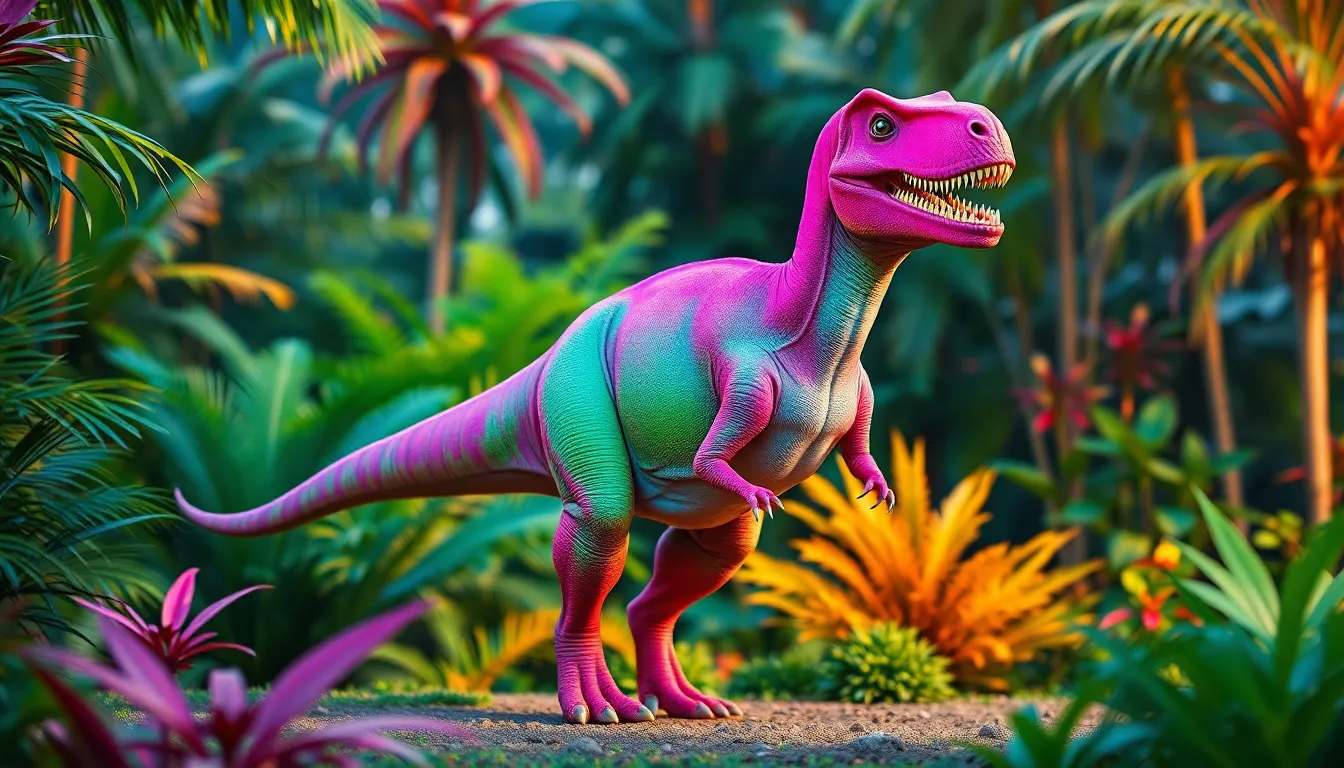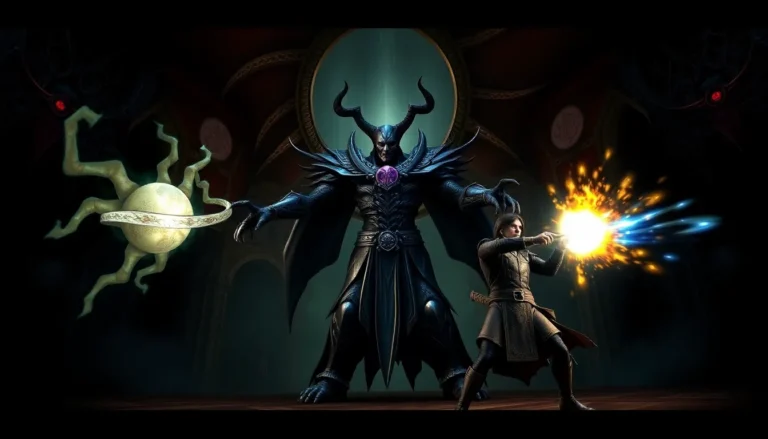In the wild world of Ark, where dinosaurs roam and survival is a daily challenge, color isn’t just for show—it’s a game changer. Imagine taming a T-Rex that’s not only a fearsome predator but also a vibrant splash of neon pink. Talk about turning heads! Understanding dino color regions can unlock the secrets to creating the most eye-catching and formidable companions on your adventures.
Table of Contents
ToggleOverview of Ark Dino Color Regions
Understanding color regions in Ark plays a crucial role in shaping the aesthetics and capabilities of dinosaurs. Each dinosaur species features specific regions where colors can be applied. Players discover that these regions impact not only appearance but also breeding attributes.
For example, a T-Rex can showcase up to six distinct color regions, allowing for a range of customization options. Players often prioritize vivid selections to create visually striking creatures. Different species have varying numbers of color regions, from as few as two to as many as eight, enhancing gameplay diversity.
Colors create a significant visual impact. When players encounter a dinosaur, the first aspect noticed often is the vibrant hues that define its uniqueness. In addition, breeding mechanics in Ark also rely on color selection. Players who understand color inheritance can guide the offspring to exhibit desired traits.
Specific colors correlate with certain species, adding layers of strategy during gameplay. Unlocking unique color combinations requires careful selection during taming and breeding processes. Players often experiment with these regions to maximize both aesthetic appeal and functionality, creating powerful allies for survival.
Color rarity exists in Ark as well. Some color patterns appear less frequently, increasing their desirability. Players go on hunts for these rare colors to enhance the distinctiveness of their collections. Understanding the interplay of regions and colors ultimately enhances the overall gaming experience, adding dimensions of customization and strategy to player initiatives.
Understanding Color Regions

Color regions play a crucial role in defining a dinosaur’s appearance and appeal in Ark. Each species showcases distinct patterns that influence aesthetics and breeding.
Genetic Influences on Colors
Genetics determine the color regions a dinosaur can exhibit. Specific genes dictate the range of colors available. For instance, a T-Rex can feature up to six unique regions, each with its own genetic makeup. Players often focus on these genetic aspects when selecting dinosaurs for unique breeding outcomes. Breeding pairs influence the likelihood of passing down desirable color traits. Rare genetic variations introduce exciting possibilities for customization and enhance the chances of producing visually striking offspring.
Environmental Factors Affecting Colors
Color adaptation in dinosaurs also results from environmental factors. Light conditions play a significant role in how colors appear. Direct sunlight can intensify certain hues, while shaded areas may alter their appearance. Habitat can shape a dinosaur’s coloration, promoting traits that enhance survival. For example, vibrant colors may attract mates or serve as warnings to predators. These environmental influences add depth to strategy, with players considering both genetics and habitat when selecting their ideal companions.
Species-Specific Color Patterns
Each dinosaur species presents unique color patterns that elevate their appeal and gameplay strategy. Understanding these patterns aids players in choosing their preferred companions.
Example: Carnivorous Dinosaurs
Carnivorous dinosaurs often showcase vibrant colors, which may hint at their predatory nature. For instance, the T-Rex displays a variety of striking color regions, including bright greens and bold reds. These options allow players to create intimidating looks that reflect the dinosaur’s ferocity. Some species exhibit up to six different colors, providing ample opportunity for customization. Players appreciate these vivid selections, as they enhance the visual impact during challenges and explorations.
Example: Herbivorous Dinosaurs
Herbivorous dinosaurs usually possess softer hues, often showcasing pastels and earth tones. The Brontosaurus is an excellent example, displaying shades of blues and gentle greens across its body. Such coloration often helps these species blend into their surroundings, adding a strategic element to gameplay. The variety of colors among herbivores can captivate players who prefer to design serene and impressive models. Understanding these subtleties in color regions allows players to create visually stunning companions that complement their adventure style.
In-Game Implications of Color Regions
Color regions significantly influence gameplay in Ark. Understanding how these colors work can enhance a player’s experience and strategy.
Breeding and Color Selection
Breeding choices heavily rely on color selection. Players often aim to combine unique color traits from parent dinosaurs, increasing the chance of obtaining vibrant offspring. Colors derived from specific genetic traits can appear in the offspring, allowing players to visualize potential outcomes. Selecting breeding pairs with desirable color regions is essential for achieving the intended look. Each species features a different color palette, which can excite players while navigating breeding strategies. Colors help to distinguish offspring, creating visually appealing companions that stand out in the wild.
Impact on Gameplay and Strategy
Gameplay is influenced by the dinosaur’s colors in several ways. Specific colors can enhance a creature’s camouflage, which may be advantageous in survival situations. Vibrant colors often signal predators, adding a layer of strategy for players aiming to remain unnoticed. Certain species showcase bright colors, reflecting their roles in the ecosystem. Tactical decisions regarding color selection can also affect breeding outcomes, ultimately influencing gameplay dynamics. Understanding how color impacts visibility and survival can benefit players during exploration and combat scenarios.
Community Resources and Tools
Many community resources exist to assist players in exploring dino color regions. Websites like ARK: Survival Evolved Wiki provide comprehensive guides detailing various dinosaur species and their color patterns. Players can reference these guides to identify optimal breeding strategies based on color genetics.
Online forums and communities on platforms such as Reddit offer discussions about color combinations and breeding outcomes. Engaging with fellow players creates opportunities for sharing successful breeding techniques and unique color finds. Valuable insights often emerge from these interactions, enhancing overall gameplay.
Color palettes in community-created tools help visualize potential color combinations. Tools such as Ark Painter allow players to experiment with different hues on their dinos before committing to breeding decisions. Visual aids empower players to make informed choices, ensuring they achieve the aesthetic they desire.
Video tutorials and streams on platforms like YouTube showcase effective color breeding methods. Many players share their firsthand experiences, which can be invaluable for those new to the mechanics of dino coloration. Watching these tutorials adds practical knowledge to the theoretical understanding of color regions.
Social media platforms also feature dedicated groups for sharing breeding successes and tips. In these groups, members post images of their unique color combinations, inspiring creativity within the community. Discussions around rare colors foster a deeper appreciation for the diverse palette within the game.
Using these resources enables players to maximize their understanding of dino color regions. By leveraging community tools, players can enhance their taming and breeding strategies, ensuring they create impactful and visually stunning companions.
Understanding the color regions of dinosaurs in Ark opens up a world of possibilities for players. It not only enhances the aesthetic appeal of their tamed creatures but also influences gameplay strategies. By mastering the art of color selection and breeding, players can create unique and powerful companions that stand out in their adventures.
With various community resources available, players can easily dive deeper into the mechanics of color genetics and breeding outcomes. This knowledge empowers them to make informed decisions, ensuring their journey through Ark is both visually stunning and strategically rewarding. Embracing the vibrant world of dinosaur colors truly enriches the overall gaming experience.





